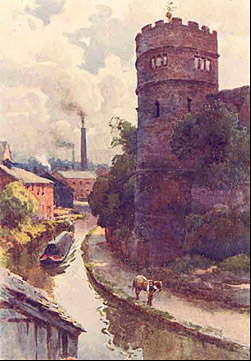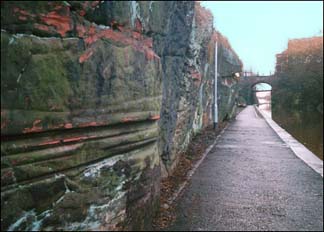Looking somewhat out of place when compared with Louise Rayner's colourful watercolours of Chester street scenes is this sepia-toned image of the Phoenix Tower and the Shropshire Union Canal.
Louise made her living from her painting but realised that, once a picture was sold, no more money was to be made from it. She therefore regularly had her paintings photographed in order to be able to offer prints for sale and here we can see an example. Colour photography was not available to her but, nontheless, these monochrome reproductions proved to be popular.
 Her subject, the Phoenix Tower is a medieval structure standing on the site of the original Roman North East Tower. It was once also commonly known as the Newton Tower, that being the name of the suburb overlooked from the wall at this point, and it is also still known today as the King Charles Tower to commemorate the stirring events of September 1645, during the English Civil War, when King Charles I, together with the mayor, Sir Francis Gamul, stood on the tower's roof and witnessed the rout of his army by Parliamentary forces after the Battle of Rowton Moor. Her subject, the Phoenix Tower is a medieval structure standing on the site of the original Roman North East Tower. It was once also commonly known as the Newton Tower, that being the name of the suburb overlooked from the wall at this point, and it is also still known today as the King Charles Tower to commemorate the stirring events of September 1645, during the English Civil War, when King Charles I, together with the mayor, Sir Francis Gamul, stood on the tower's roof and witnessed the rout of his army by Parliamentary forces after the Battle of Rowton Moor.
The inscription upon the tower states: 'KING CHARLES STOOD ON THIS TOWER SEPT 24th 1645 AND SAW HIS ARMY DEFEATED ON ROWTON MOOR'.
Actually, it would have been impossible to see the field of battle from here- what they probably witnessed was later action on Hoole Heath (now the pleasant suburb of Hoole, where these words are being written) and fugitives from the fray being pursued and harried through the eastern suburbs.
But what of the Phoenix? By the mid-17th century, the tower was in a ruinous condition, due largely to the battering it had received during the Civil War. It was nontheless taken on as the meeting place of two of the city guilds- the Company of Barber Surgeons, Tallowchandlers and Wanchandlers, the other was that of the Painters, Glaziers, Embroiderers & Stationers- on the understanding that they  would put it in good order and subsequently maintain it. The badge of the Painter's Guild was a Phoenix and a carving of the mythical bird, together with the date 1613, was placed by them above the door to the lower chamber, where it may still be seen today. would put it in good order and subsequently maintain it. The badge of the Painter's Guild was a Phoenix and a carving of the mythical bird, together with the date 1613, was placed by them above the door to the lower chamber, where it may still be seen today.
The Phoenix Tower was later also let to various of the other companies, including the barbers, coopers, butchers, weavers, joiners and clothworkers, and in this way became the headquarters of the city guilds. They held their meetings in the upper chamber, which was strewn with rushes and decorated with garlands of flowers at their annual meeting on the festival of St. Luke in October.
Their carved crests, along with the old phoenix, were formerly displayed on the tower, but around 1810, they were replaced with the much-photographed commemorative plaque we see above the door today, together with a second, newly-carved phoenix.
The Chester Canal was inaugurated in 1772 and became part of the Shropshire Union Canal in 1842. This section of the canal was opened in 1776. Both of our illustrations show a horse-drawn barge negotiating the canal as it curves around the base of the Phoenix Tower. Their towropes would rub against the rock face on the sharp corner resulting in deep grooves being carved into the sandstone. As our photograph shows, these can still be clearly seen today.
The canal and Phoenix Tower can be clearly seen in a detail from John McGahey's spectacular 1855 View of Chester From a Balloon... |

